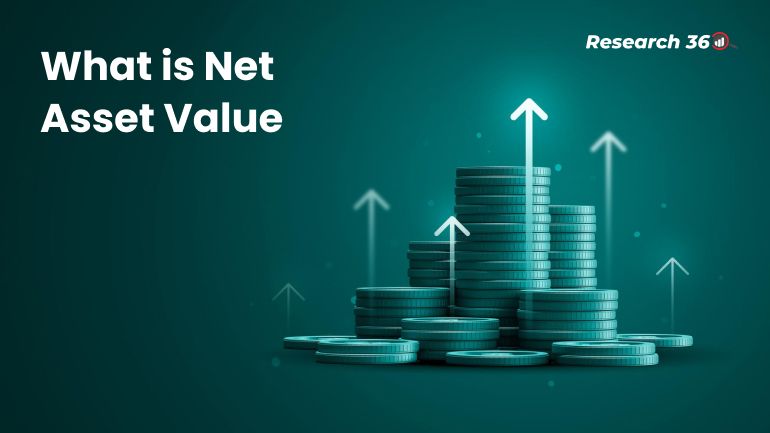What is Net Asset Value?

Mutual funds have become a popular investment avenue for individuals looking to meet their long-term financial goals. One of the many advantages of mutual funds is that you get exposure to a diversified portfolio of assets, which can reduce volatility and market risk to a certain extent.
If you’re a beginner to the stock market and are planning to invest in mutual funds, you need to know what net asset value is. It is a fundamental concept, whose understanding is crucial to make informed investment decisions. In this article, we’re going to define NAV in mutual funds, look at the formula that’s used to calculate it, and see how relevant it is to you.
What is Net Asset Value (NAV)?
Net asset value or NAV is the term that market experts use to refer to the per unit value of a mutual fund. When you purchase or sell units of a mutual fund, you do it at the NAV prevailing at the time of the transaction.
In addition to denoting the value of a mutual fund unit, the NAV can also give you insights into the fund’s performance over time. The Net asset value of a mutual fund is calculated by the respective fund house or Asset Management Company responsible for managing it.
What is the Formula for Calculating Net Asset Value?
Now that you’re aware of the meaning of NAV, let’s take a look at the formula that fund houses normally use to calculate it.
Net Asset Value = (Total Assets - Total Liabilities) ÷ Number of Outstanding Units
Here, total assets refer to the total value of all of the investments that the fund has made. Total liabilities, meanwhile, represent all the expenses and costs that the fund house incurs to manage the fund. This includes administrative expenses, marketing expenses, agent commissions, and salaries to fund managers, among others. Finally, the number of outstanding units refers to the total mutual fund units created up until the point of calculation of NAV.
Net Asset Value - An Example
As an investor, merely knowing the formula used to calculate it may not be enough to understand how it works. Therefore, we’ve come up with a hypothetical example to help you give more clarity.
Assume there’s a hypothetical mutual fund. The total value of all of the assets the fund has invested in at the end of a particular trading day is Rs. 50 crores. The total liabilities including all possible expenses in connection with the fund at the end of the same trading day is Rs. 5 crores. The total number of outstanding units of the mutual fund as of that day is 1 crore. Using these figures in the above-mentioned formula should give you the net asset value of this hypothetical mutual fund. Let’s check it out.
Net Asset Value = (Rs. 50 crores - Rs. 5 crores) ÷ 1 crores = Rs. 45
As you can see, the NAV of the fund is Rs. 45. Now, if you were to purchase or sell units of the mutual fund, you would have to do it at Rs. 45 per unit.
How Frequently Does the Net Asset Value Change?
The net asset value of a mutual fund hardly remains static. In fact, it fluctuates based on how the fund’s assets perform. As per the regulations of the Securities and Exchange Board of India (SEBI), all mutual fund houses are required to disclose their NAV at the end of every trading day.
This effectively means that fund houses use the above formula at the end of each day to calculate and update the NAV of their funds. The daily update of the net asset value ensures that investors have up-to-date information about the value of every fund’s units so that they can make well-informed investment decisions.
While the update of the NAV happens at the end of every trading day for regular mutual funds, it's not the case for exchange-traded funds. Exchange-traded funds or ETFs are mutual funds that are listed and traded on stock exchanges like equity shares. Interested investors can purchase and sell units of an ETF on exchanges as and when they wish. Since the units of an ETF are constantly traded, their net asset value also fluctuates with every executed trade like stocks.
Why is the Net Asset Value Relevant?
As an investor, you need to understand the relevance of net asset value to make informed decisions. Let’s take a look at some reasons why it is highly significant.
Buying and Selling
NAV plays a pivotal role in determining the price at which you can buy or sell mutual fund units. The declaration of NAV at the end of the trading day ensures fairness and transparency for all investors.
Performance Evaluation
The net asset value can serve as an indicator for assessing the performance of a mutual fund. By tracking the NAV over time, you can easily gauge how well the fund has been managing its assets and delivering returns.
Fund Comparison
NAV lets you compare similar mutual funds to gain insights into which of them may be more suitable for your investment style and objectives. For instance, if two similar funds have different NAVs and your investment capital is limited, you could choose to invest in the fund with the low NAV since it would allow you to purchase more units.
That said, it is important to keep in mind that not all funds with low NAVs may be attractive, whereas funds with high NAVs are not bad investment options. When evaluating a fund, factors like historical performance, risk, and investment objectives should be considered.
Risk Assessment
The net asset value of a mutual fund can also give you information on the level of risk involved. For instance, if the NAV changes wildly, it indicates high volatility and that the underlying assets are prone to significant market fluctuations.
Income Distribution
The net asset value of a mutual fund is crucial for determining the dividend investors. This is because dividends are often distributed based on the NAV.
Conclusion
To sum up, net asset value or NAV is an important metric in the context of mutual funds. As an investor, simply knowing the meaning of net asset value isn’t enough. You must also be aware of how it is calculated and monitor the changes over time. That said, remember to also consider other factors like fund objectives, the experience of the fund manager, and expense ratio, among others before investing.

















